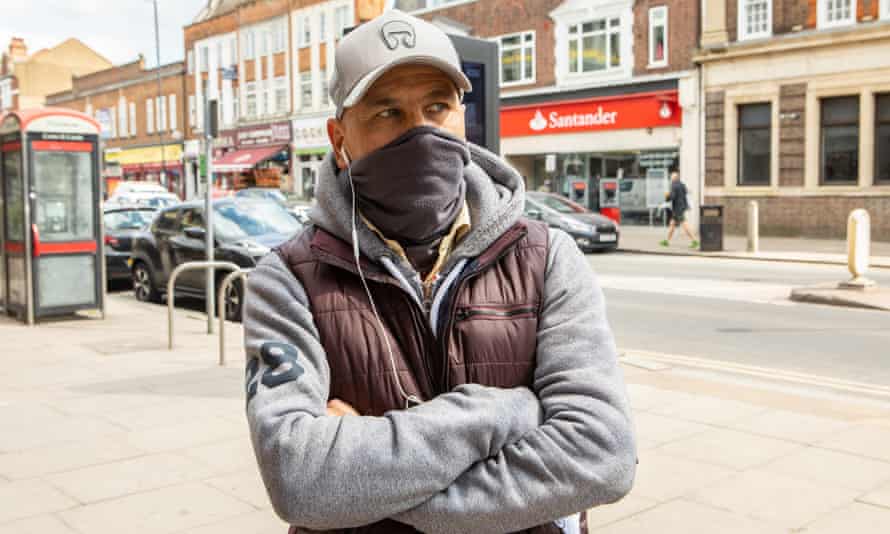The steady stream of people at the two surge testing units in Finchley, north London, last week suggests that, more than a year after the pandemic hit, the public spirit to do something about Covid is still strong.
The effectiveness of surge testing is a more open question, however. The rapid testing of 5,000 households last week was an attempt to isolate the South African variant and others of concern. Yet although standard PCR tests come back within 24 hours, genomic sequencing tests to identify a Covid variant take 14 days – by which time the period of infectiousness is usually over.
It was clear from talking to people in north London that public awareness of the distinction between regular testing and surge testing was not always obvious, despite the strong desire to help.
“There’s been something around here – they’re having a surge of the South African variant,” Avril Endfield said on Friday, before taking one of the tests on offer at the black tent outside Tesco’s. “I’ve had one vaccine and I’m having another in 10 days. My daughter is about to give birth and I’d really like to be able to see her. Hopefully this will help me do that.”
Rino Sampieri’s motivation for testing was similar. “I’ve been semi-shielding for my mother and I’m flexi-furloughing,” he said. “I haven’t got any symptoms and I don’t think I’ve got it, but … anything to get the economy back up and running.”
Barnet council was doing a surge test because of evidence that one person in the Finchley postcode area had the South African variant. Existing vaccines are currently less effective against it, and it may spread more readily than others.
Dozens of areas around England have been subject to surge testing since February. Most, like the test in Finchley, involve only one or two confirmed cases, and so far none of the variants has spread far.
But public health officials were concerned last week when 44 cases were identified in the south London boroughs of Lambeth and Wandsworth, with 30 more suspected, triggering a large bout of localised testing. The case in Finchley is unrelated.

Barnet set up two mobile testing units and sent a team of seven people door-to-door to hand out kits, which are used at home, then returned the next day. About 5,000 kits were handed out and 80% were returned.
Despite the 14-day delay, surge testing was still valuable, said Dr Tamara Djuretic, Barnet’s director of public health. “There is no better way of doing it, and the important thing is that we still contain the infection, and you treat them as if they are all a variant,” she said. “Once you start searching in that area, everyone becomes extra aware that something is going on, and their behaviour changes.”
This is the third surge test Barnet has done. The first, of about 10,000 people in East Finchley and Hendon at the end of February, found no variants of concern. “It was good, because it was opportunistic testing and we found some positive cases that wouldn’t otherwise have been discovered,” Djuretic said. But it seemed that the variant had not spread.
The second test, in Muswell Hill, was looking for possible transmission of the Brazilian variant from someone who had arrived in the UK. “We did discover evidence of transmission of the variant within a few households,” she said. “This was during the first lockdown so contact was quite limited.”
Surge testing is “an important tool in the public health armoury,” according to Jim McManus, the vice-president of the Association of Directors of Public Health.
“You can’t expect residents to do it all the time,” he said. “You have to discern when it’s worth doing.” He said he was “frankly astonished” by the high take-up of surge tests. “Our efforts with the South African variant are still focused on containment,” he said. “Surge testing can be extremely useful when you think there is the possibility of community spread and where you’re finding it difficult to contact-trace people beyond the immediate network of contacts.”
A third technique that a number of public health officials are using is network analysis. When an infected person talks to contact tracers, they give information about where they have travelled, and analysts will look for cases where postcodes overlap, to try to find how a virus has spread.
“It takes time, but it certainly produces results,” McManus said. “We found one person who was going around three different offices in a company, who was the common factor in spreading the virus.”
Enabling people to self-isolate was still crucial, he said. And surge testing and tracking variants using waste water analysis are both useful, but they too rely on genomic sequencing. “Our ability to do genome sequencing in this country is far and away one of the best in the world,” he said. “But it takes too long and needs to be speeded up.”
This content first appear on the guardian
